

Exhibition

For this exhibition, I present the transformative process of imaginary and biological mutation by enquiring into its history. From mythical tales to rational science, mutation has been a fictional trope as much as a biological manifestation, while often carrying negative connotations. A recurrent representation of mutation in fiction has assumed the shape of ghosts, monsters or mutants. By looking at the history of these representations and manifestations in Japanese and global cultures, I ask what mutated and shapeshifting creatures are telling us about human beings and their fears, about the eco-social impact of their activities, and how humans have tried to cope with ongoing mutations and transformations in the environment, society and culture through the ages. The gallery space is divided into three sections representing the past, present, and future using video projections, image reflections, sounds, and scents, I create a specific atmosphere in time and space.
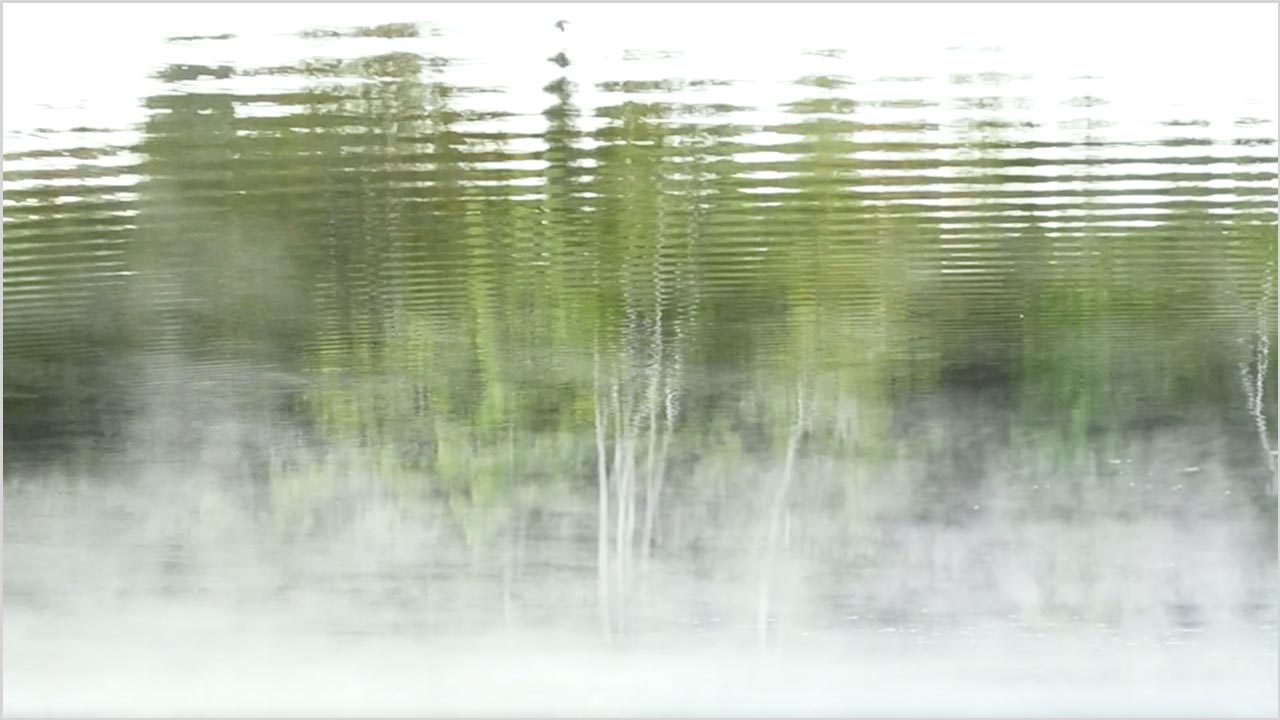
In the first section, I show psychological mutation from the perspective of traditional Japanese theater, painting, literature, Buddhism, Shintoism, and aesthetics of nature, especially by rethinking the aesthetics of Noh theater which Zeami Motokiyo (1363-1443) developed 600 years ago. I depict ghosts as mutating spirits or apparitions, revising traditional readings of these beings through their abilities to transform and to haunt, and how they are perceived as threats that need to be exorcised. In my work, I focus on the spiritual side of Noh plays, whose structure and aesthetic are believed to release the human soul from suffering, torment and earthly attachments, enabling it to reach enlightenment. Through its high degree of abstraction, the Noh stage acts as a bridge connecting the worlds of the living and the dead, light and darkness, purity and impurity. The ghost characters in Noh theater may also be viewed and depicted as scenery. For my video work, I use excerpts of the English translation of the Noh drama Yamamba (The Mountain Crone). The demon yamamba has variously been viewed as a symbol of motherhood, as an incarnation of nature and the cosmos, as an embodiment of wisdom and human enlightenment, and finally as a feminist figure. This Noh play beautifully expresses one of the main tenets of Zen Buddhism according to which wrong and right are one or two faces of the same coin (jyashouichinyo). In images and sounds, I depict a concept of Japanese aesthetics called yūgen which means subtle profundity. In the video, I show recorded footage of fog scenery over a lake in order to create a sense of mystery and passage between two worlds.
Watch Excerpt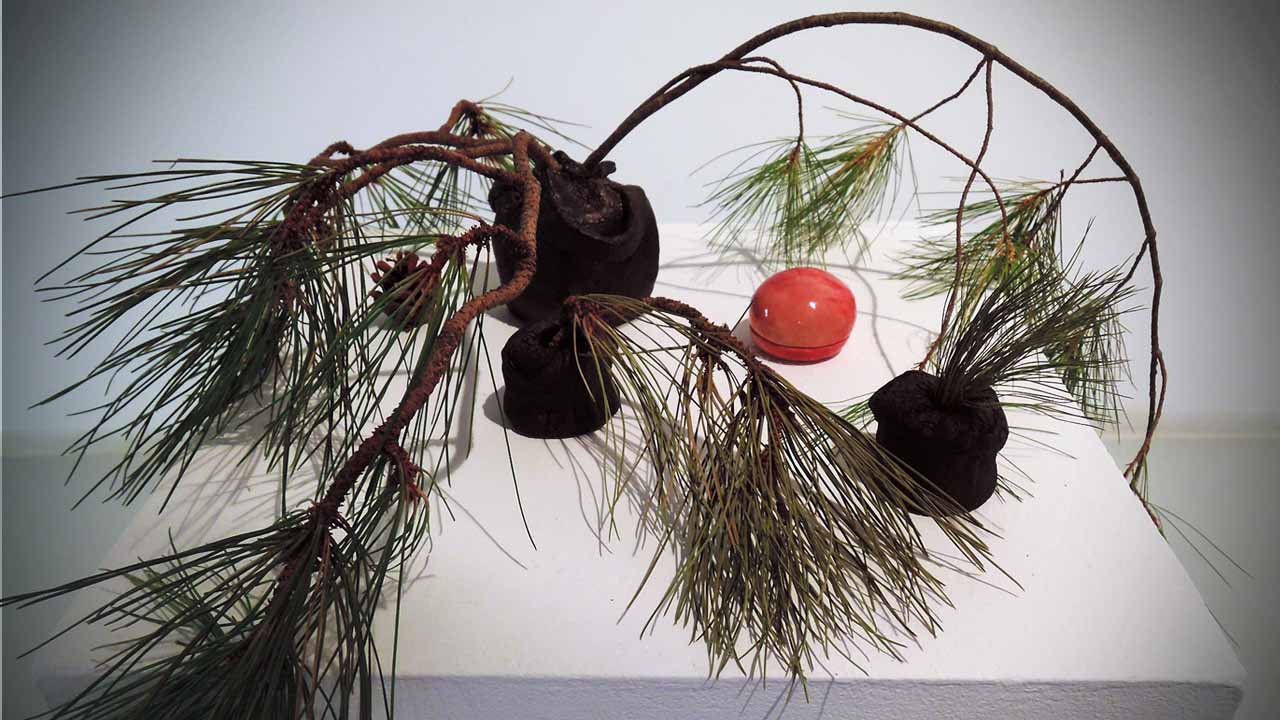
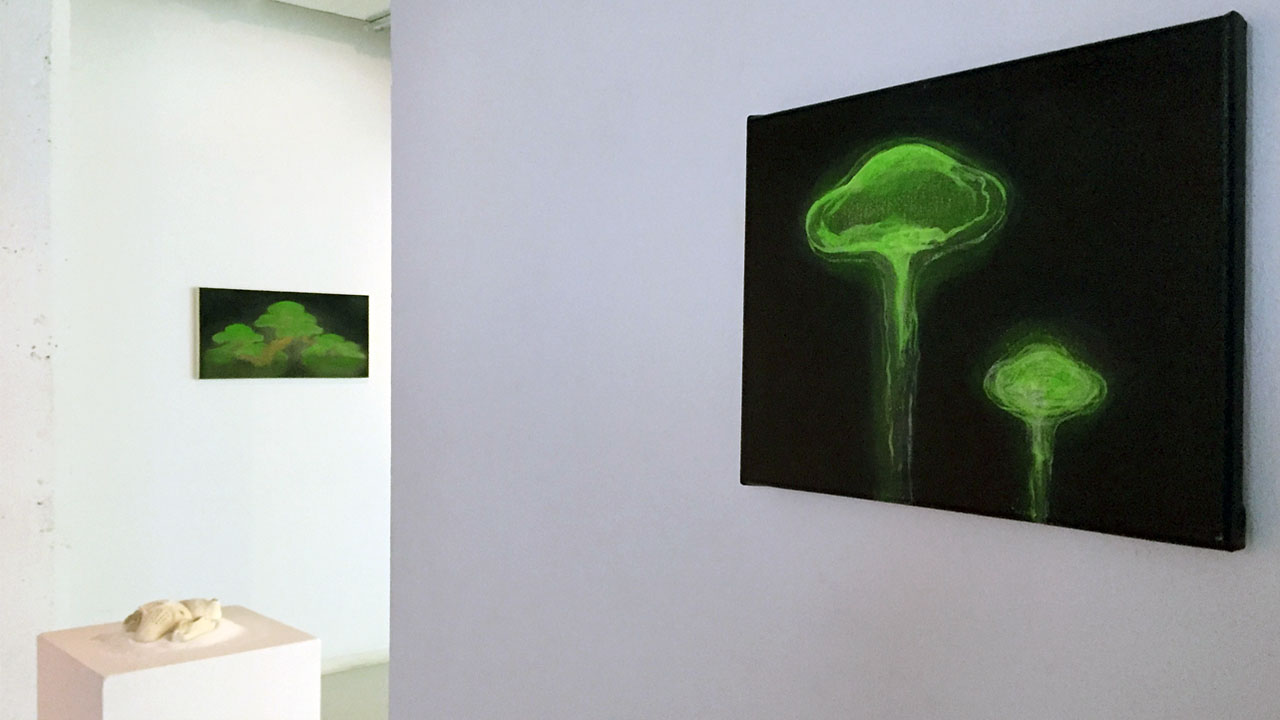
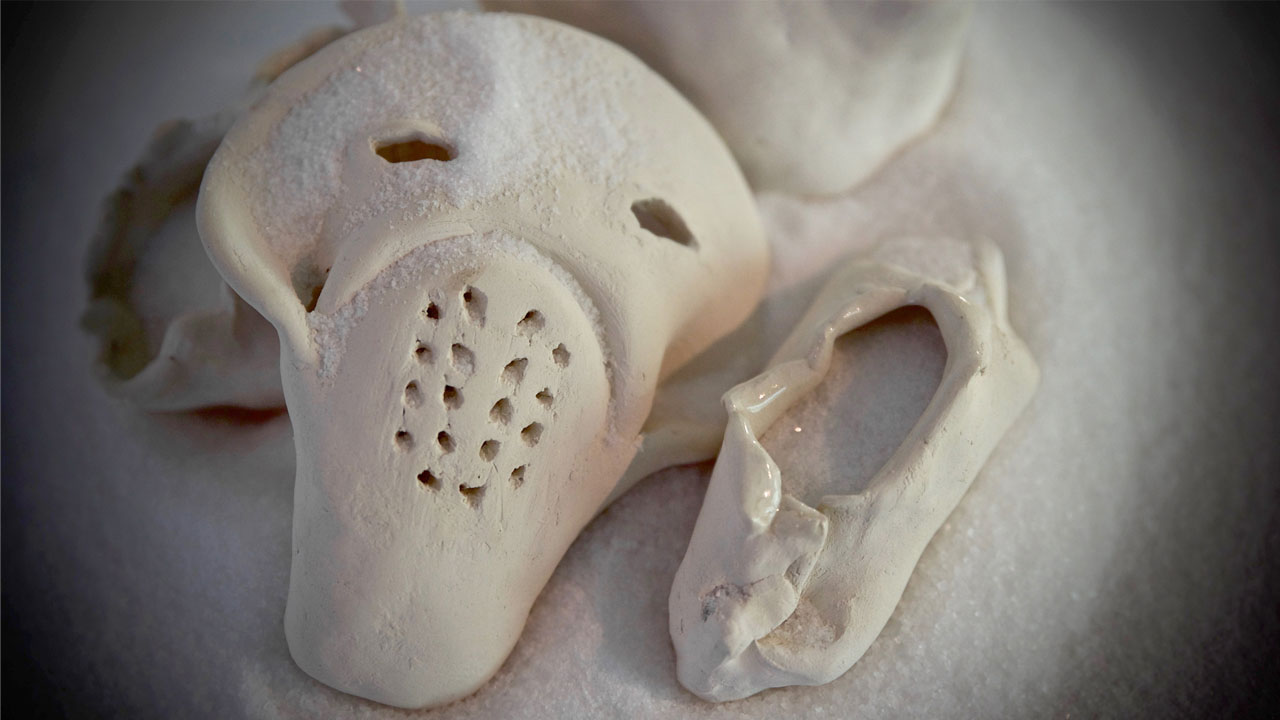
(Photo: Marc Joly-Corcoran)
As an abstract figuration of purity and detachment from worldly desires, and because it was an important motif in classical Japanese painting, I paint images of pine trees. The pine tree images are based on the Noh stages of the Kasuga-taisha shrine and the Itsukushima shrine and the Pine Trees Screen (Shōrin-zu byōbu) by Japanese painter Hasegawa Tōhaku (1539-1610). As part of the installation, real pine trees, piles of salt, and some of my mutated ceramics (itself a transformative process) embody the continuous need for the purification of haunted human spirits and minds.
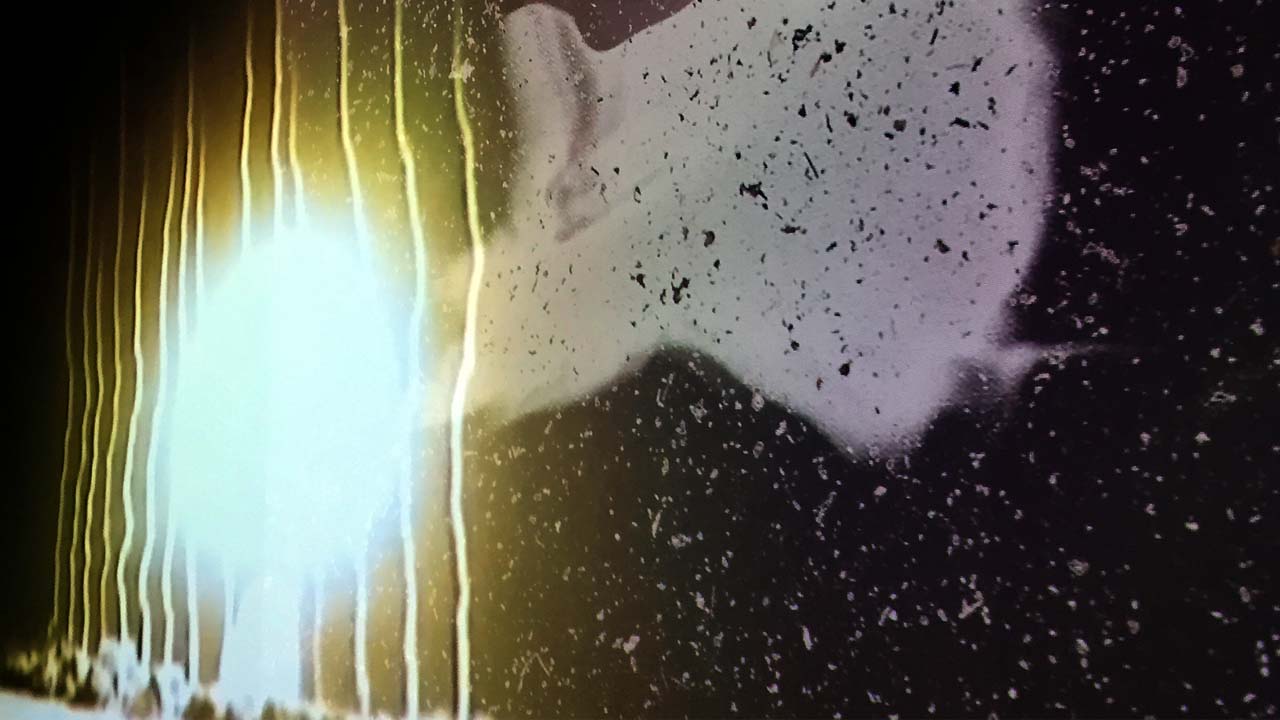
Using two projectors, I create a video in the form of a triptych to suggest that transcendental imagery, reasonings and arguments (from religion or other forms of spiritual beliefs) have been used to justify materialist discourses and economic policies, such as the well-known discourse that equates atomic power and nuclear weapons with the natural power of the sun. Video footage of nuclear bomb tests and of the explosion of an atomic power plant is shown in contrast to my satirical stop-motion animation of mutated characters. I express the fuzzy materiality of the process of mutation by experimenting with video speed, color palette, and gradation. Although radioactivity is not visible, I visualize the inherited influence of signal transduction and DNA generation as visual glitches of organic waves and particles by applying the technological damaging effects of videotape. Showing vibration loops and the influence of invisible radioactivity, I suggest that radiation causing tumors and cancers could be associated with the fungus realm, and that this manifestation appears repeatedly through generations.
In a radioactive environment produced by nuclear energy and nuclear weapons, mutation effects represent a reaction or adaptation to poisoning such as may be seen in contaminated or irradiated bodies that emerge, like ghosts, haunting the human species and its irresponsible behavior, biologically as much as ethically. I posit that mutations ghosts and ghostly imagery can be seen as placeholders for nuclear materiality (especially low dose radiation exposure) and for the environmental impact of nuclear power. They can also represent other poisonous or toxic elements: human hubris and desire for mastery of nature; a capitalist globalized economy bent on extracting the world’s resources for endless growth and capital accumulation; destructive competition for money and power; the exploitation of the poor and the violence of settler colonialism; toxic ideas and politics such as racism, xenophobia and misogyny. Mutation exists in the in-between of two states and times (a beginning [now past] striving toward an upcoming end [future]), in a process of transformation.
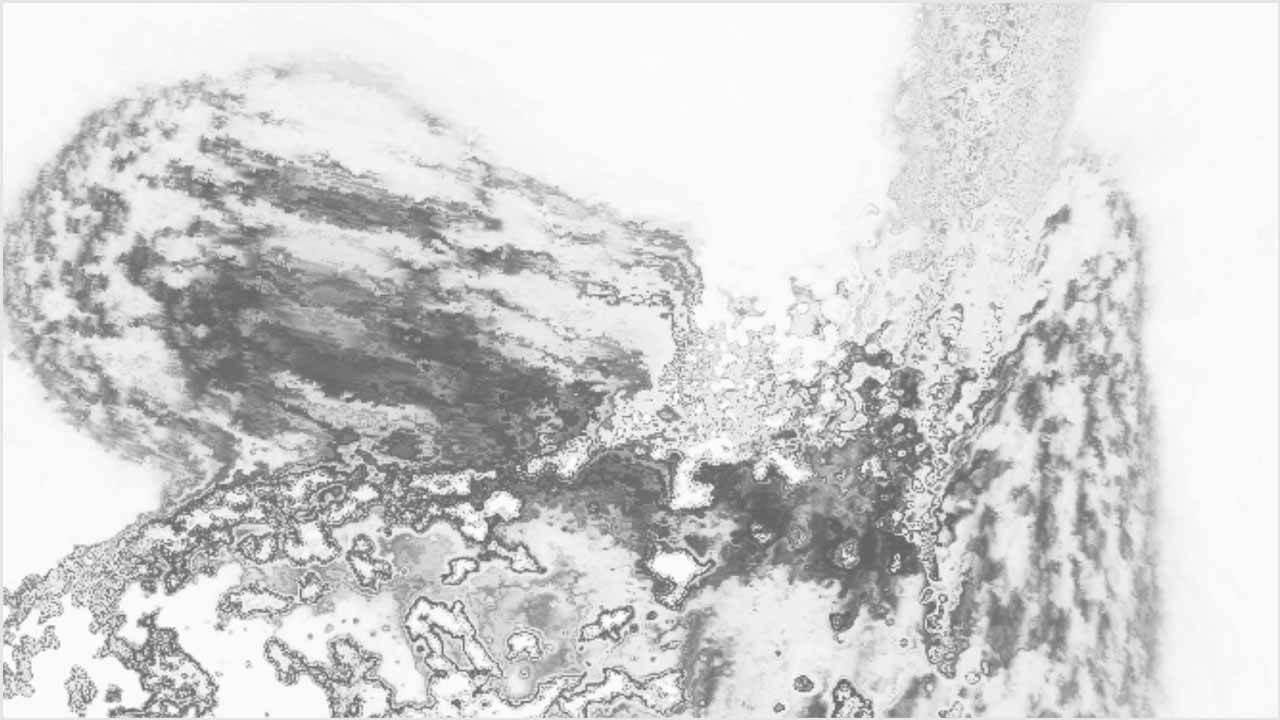
Finally, in the "future" section of the exhibition, the question is: is there a future for humanity and the planet? My hypothesis is that mutation will become the solution for (biological) survival. The universe has cosmic rays and the Earth has been irradiated since the time of its birth. Living creatures have mutated through the process of evolution (genomic variation) and have adapted to the environment. Although life processes are limited in time, on another scale, life is also in continual circulation, transformation and form-changing as energy and movement, just like atoms and light (as wave-particle). Even in a contaminated environment, some bacteria can and will survive, such as Deinococcus radiodurans, which is one of the most radiation-resistant organisms. I animated a spontaneous mutation act that changed in form, character, and substance, indicating a potential path through damaged chromosome and DNA repair, bacteria, and spirit. In the Anthropocene epoch of climate change, widespread radiation damage, arctic ice melting, deepening ocean acidification and planetary deforestation, critical thinking on mutation ecologies is a pressing issue. The human species seems bound to self-destruct, by accelerating their risk of extinction. However, even without human beings, I envision a prosperous life for other living creatures on the planet as millions and billions of bacteria and microorganisms will be able to adapt (through mutation) to a toxic radioactive environment. I picture the passage of mutation processes in a toxic environment by using scanned digital images and the sound of the universe (recorded by NASA). As an abstract idea of purification and detoxification, microorganisms (bacteria, yeasts, molds, and fungi), mitochondria, energy (light, gravity, heat, and wave or vibration) and Mu (which refers to the ancient Greek word μῦ as well as the concept of emptiness and nothingness from Buddhism) are expressed. Ghosts are no longer lingering.
Watch Excerpt
(Sound and Light: Garrett Lockhart / Photo: Edwin Isford)
"Les temps mutants" explored the psychological and biological aspects of mutation, focusing on changes in physical form and substance. Mutants amphibians represented the irradiated bodies in which the reproductive system was metamorphosed into the erotic. The invisible materiality (or, radioactivity) was rendered visible through a reimagination of Japanese and Western folklore. My work also engaged with fantasy; I depicted mutated landscapes whimsically, and in the process, reinterpreted dystopian environments produced by highly destructive technology.
The works represent grotesque existences where creatures are troubled not only internally, but also externally, through radioactive contamination. "Les temps mutants" emphasizes our period of rapid change where "mutation" has become a symptom of the Anthropocene. It is a time for mutants.
View More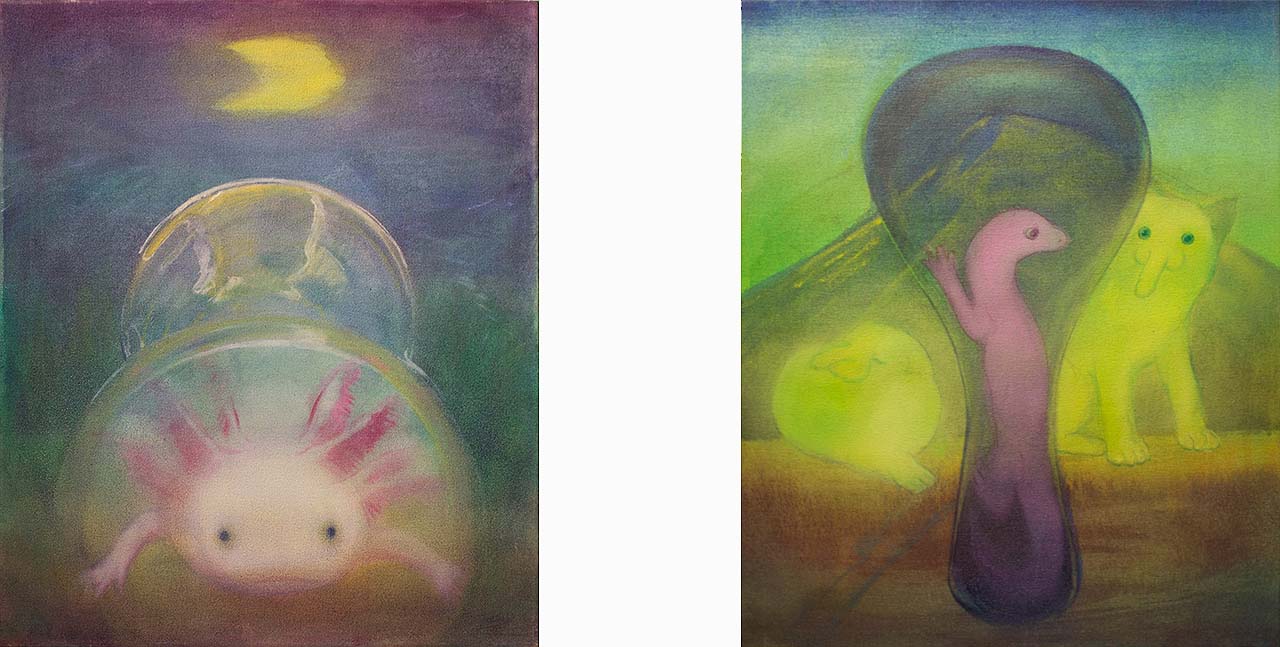
The Mutation series depicts the mythical, biological, and psychological structures of mutation. The process of mutation is also represented through "neoteny," which refers to the retention, in the adults of a species, of juvenile physical characteristics.
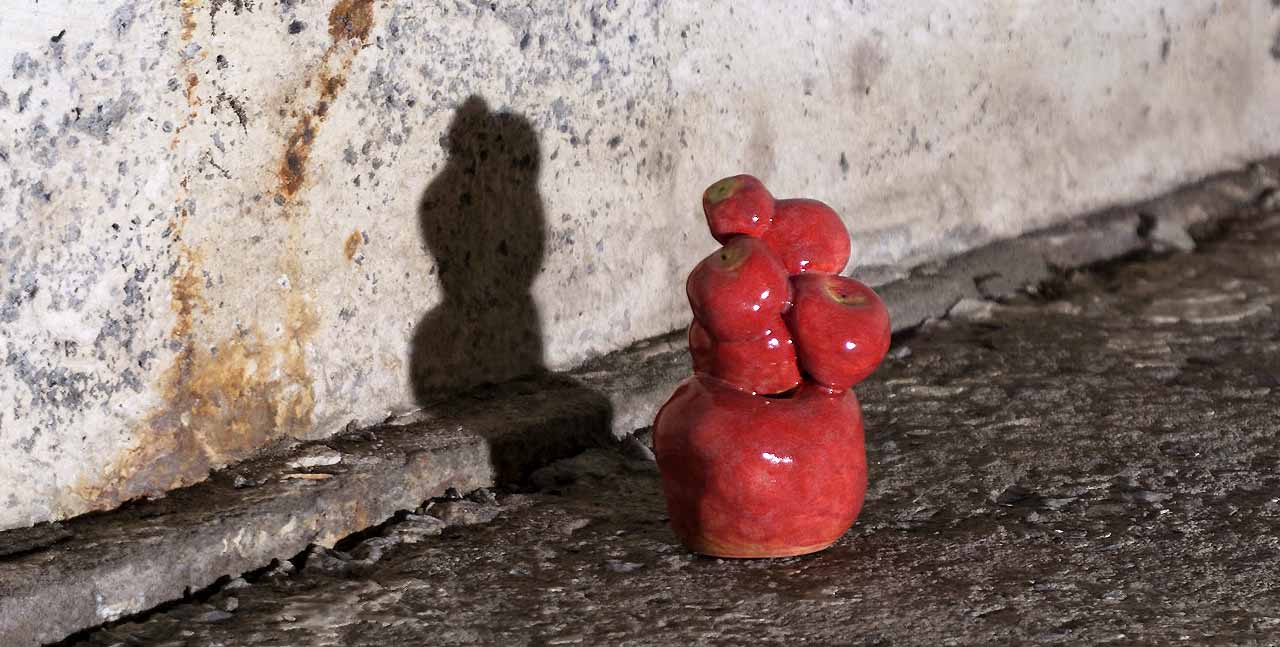
The main reason for using Japanese traditional formats of ceramics was to question the nuclear history of Japan, by creating malformed objects that were representing anxiety and the grotesque through fantasies. I built mutated shapes and created textures through melted surfaces to recall radioactive exposure and burns from the atomic bombs of Hiroshima and Nagasaki. The dysfunctional altered shapes also represent the nuclear meltdown/melt through and the leaking system of contaminated water that happened at the Fukushima atomic power plants. My interest in ceramics was also to study the aspect of solidity affected by high temperature as well as the properties of objects in three-dimensional space, something that couldn't be studied in two-dimensional paintings.

"Nuclear Body" was the title of my exhibition room for the group exhibition of the Concordia University's MFA Department of Studio Arts. 17 pieces of my artworks were exhibited, including three series — Dissociation, Anatomy, and Interpretation series — which related to the multifaceted dimensions of nuclear energy and culture.
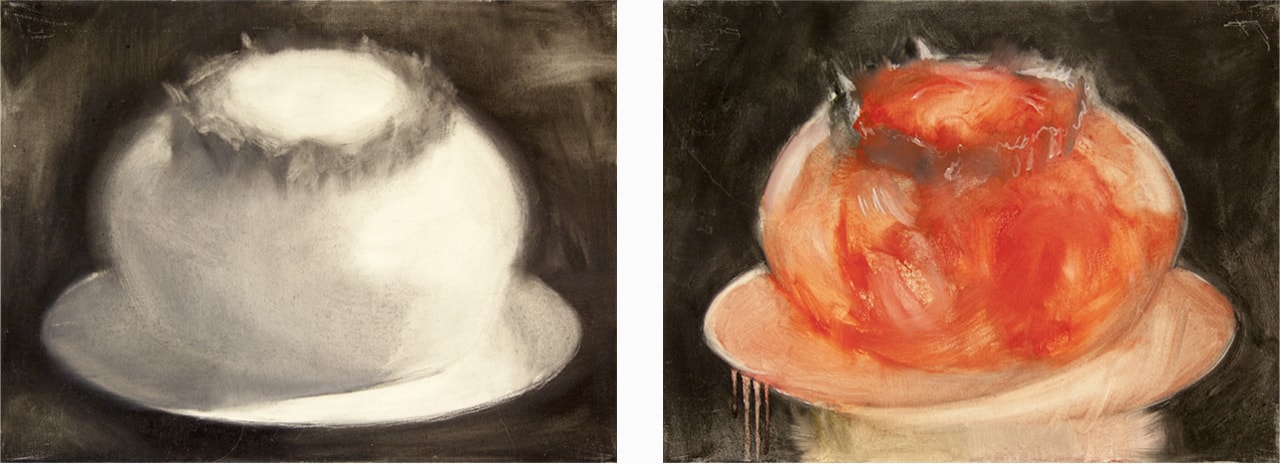
The painting on the left side is Nuclear Weapon Test which is based on the nuclear weapon test named Baker in Operation Crossroads which the United States of America conducted in the Bikini Atoll in 1946. It was held after the Trinity in July, Hiroshima and Nagasaki in August 1945. The painting on the right side named Tumor represents the radioactivity causing tumors, such as cancers.
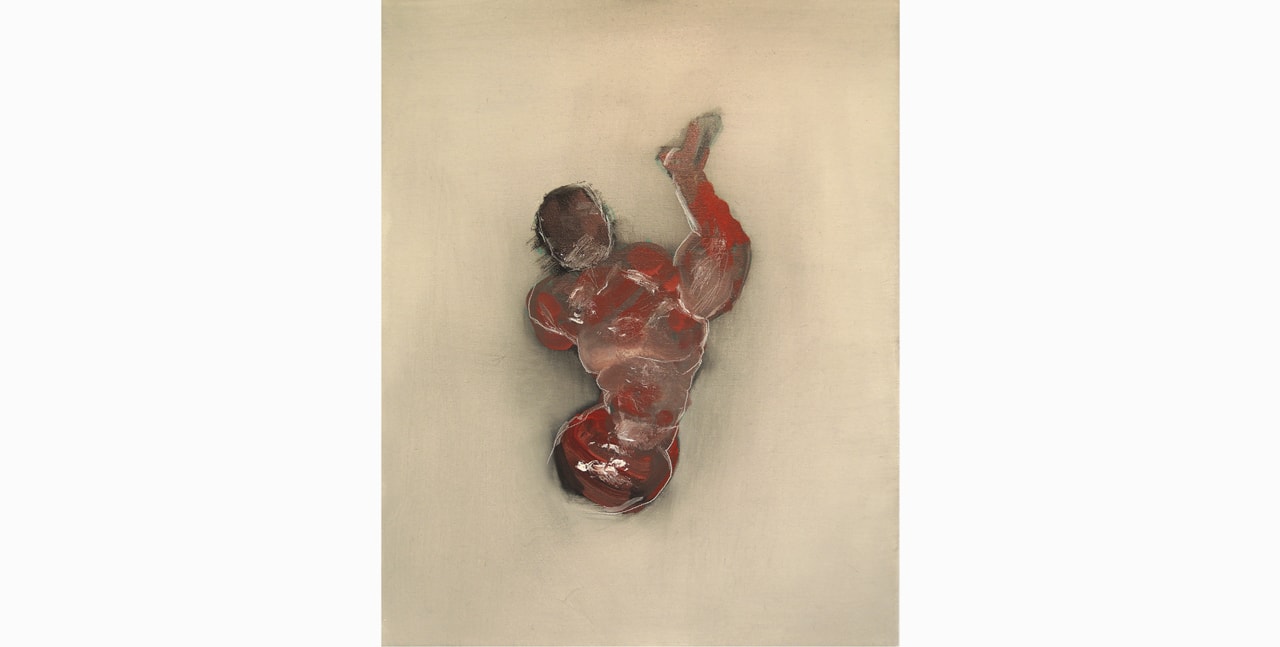
The painting, which is the application of a mental collage of some parts of a malformed baby, suggests the structure or system of the body without any bones inspired by the idea of Deleuze and Guattari's "body without organs" and the works of Francis Bacon. It is also as an allegory of how the human world is not able to sustain itself.
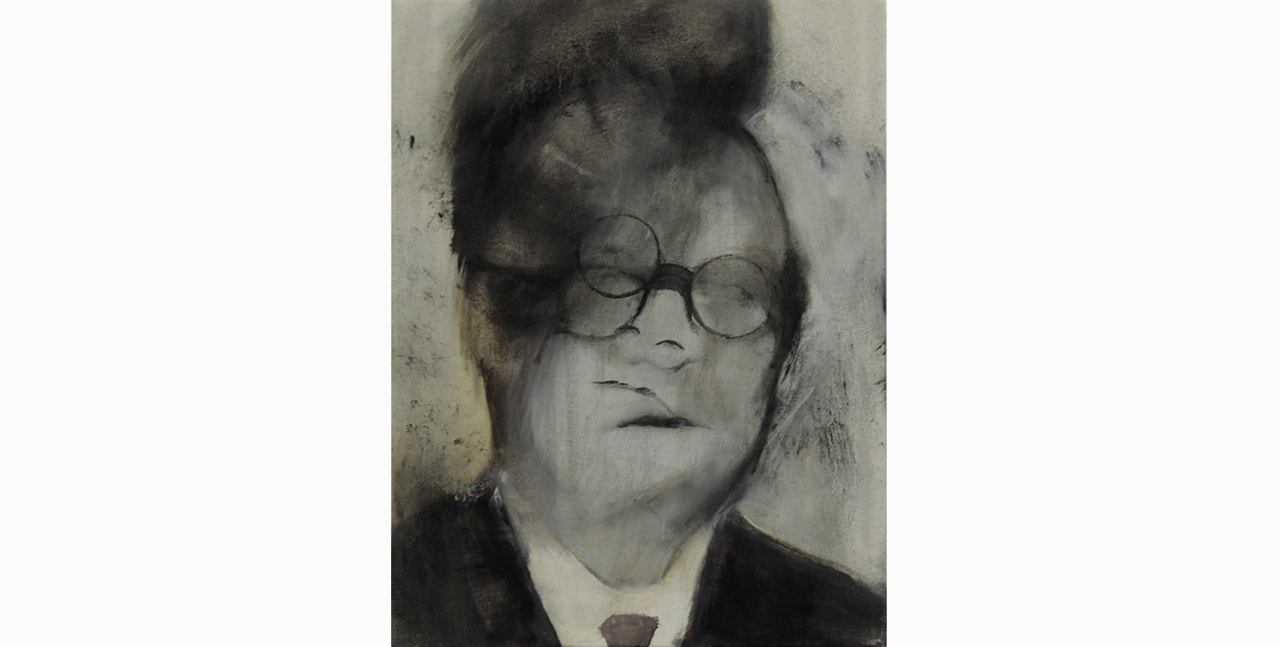
Podam is the CIA code name of Matsutarō Shōriki, called "the father of nuclear power generation" (but also known as the father of Japanese professional baseball). Shōriki owned the Yomiuri Shimbun, one of Japan's major daily newspapers, and founded Japan's first commercial television station, Nippon Television Network Corporation. He was also the first Chairman of the Japanese Atomic Energy Commission and Head of the Science and Technology Agency, supported behind the scenes by the CIA. It represents Shōriki's mentality and the hidden part of the nuclear industry.

"The exhibition HŌSHANŌ: Art and Life in a Post-Fukushima World initiates a dialogue between Quebec and Japan regarding the Fukushima disaster, which Jean-Luc Nancy termed a "civilizational catastrophe." Its consequences disturb life itself, haunt the collective memory and change our way of understanding the world. Hōshanō, which means "radioactivity" in Japanese, questions the nature of this invisible enemy released during the fusion of the reactor core of the Fukushima Daiichi power plant. Beyond the ruins and devastation of the Tōhōku region made visible in the media, the radioactive threat is invisible and insidious; it contaminates all the elements that surround it and is inscribed on a vertiginous duration calculated in terms of half-lives. The era of the atom becomes that of self-destruction, that of a war without an enemy. Thinking after Fukushima becomes imperative for the future of our civilization. Today, on the sixth anniversary of the triple catastrophe and the official entry of the world into the Anthropocene era, this exhibition is introspective: what kind of world will we bequeath to future generations?" (Exhibition statement written by Amandine Davre, Curator)
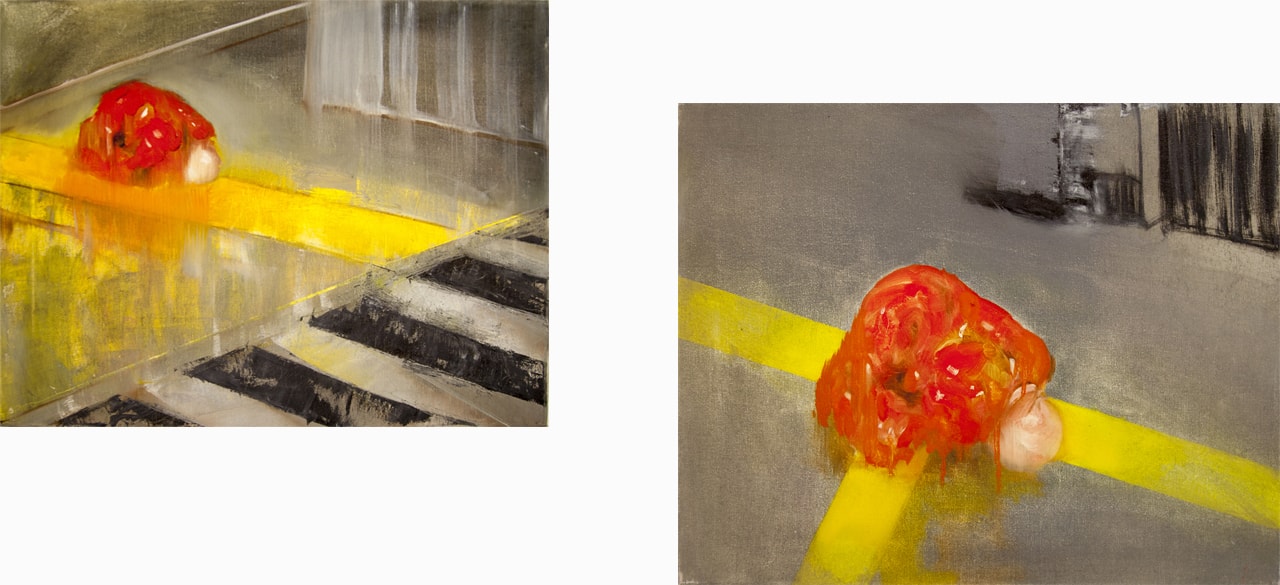
The Dissociation series explores the psychological aspects of "dissociation" in Japan, focusing on individual and collective practices of self-defense and self-censorship, and attitudes of denial. The works represent people's minds and bodies as separated and divided, where people are troubled not only internally, but also externally through radioactive contamination.
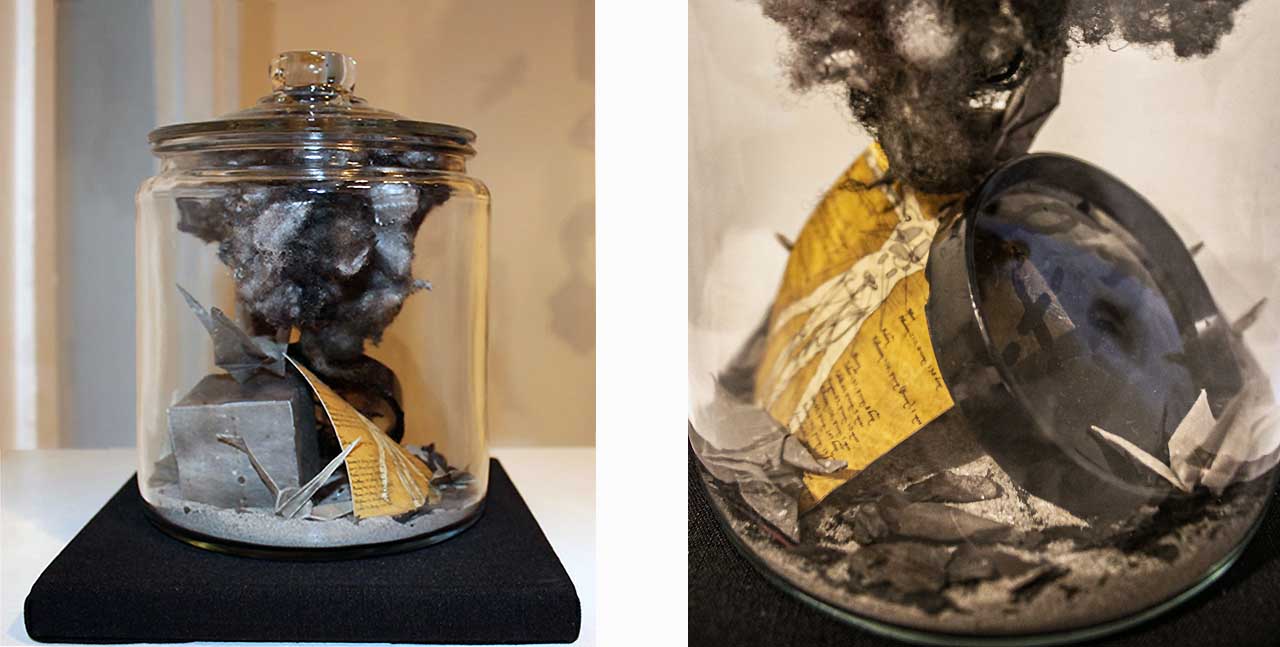
This work reminds us that despite the process of historical repression in the face of the anxiety of the past, the impact of irradiation on the skin and biological tissues persists. And even after the body become ashes and dust, the nuclear materials remain.
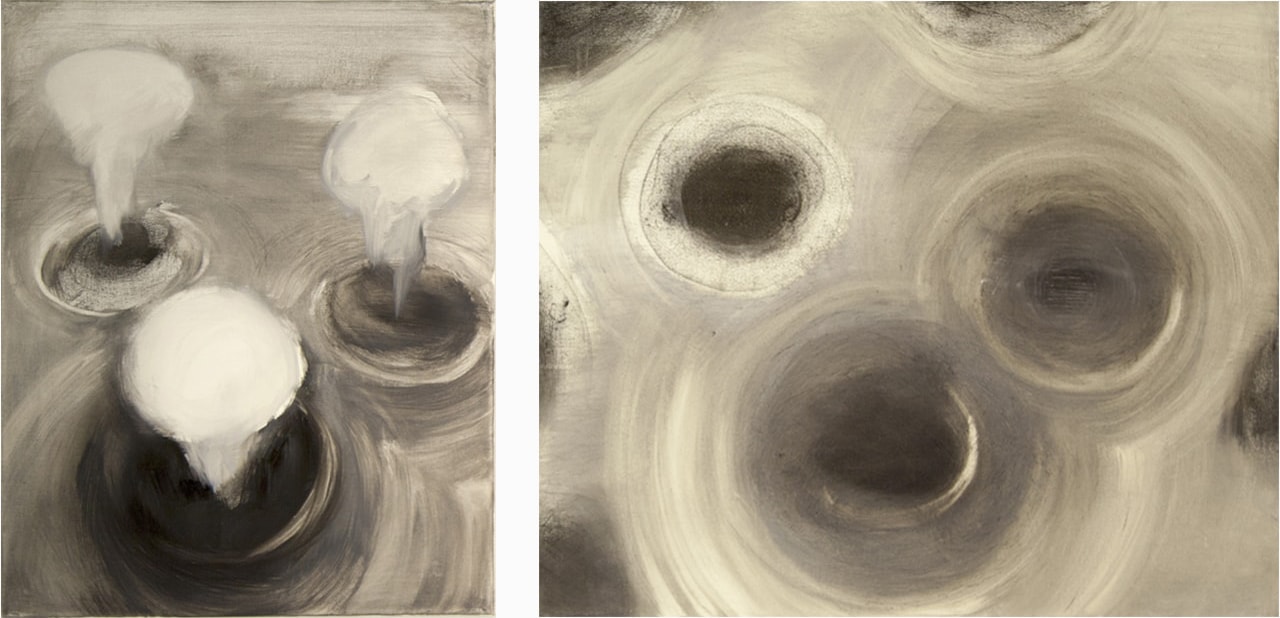
These works express the radioactive incidents in Hiroshima, Nagasaki, and Fukushima in Japan, but also the others in history. The "atomic" transcends time and space, as well as the visible and the invisible, through contamination and the continuous spreading of radioactivity.
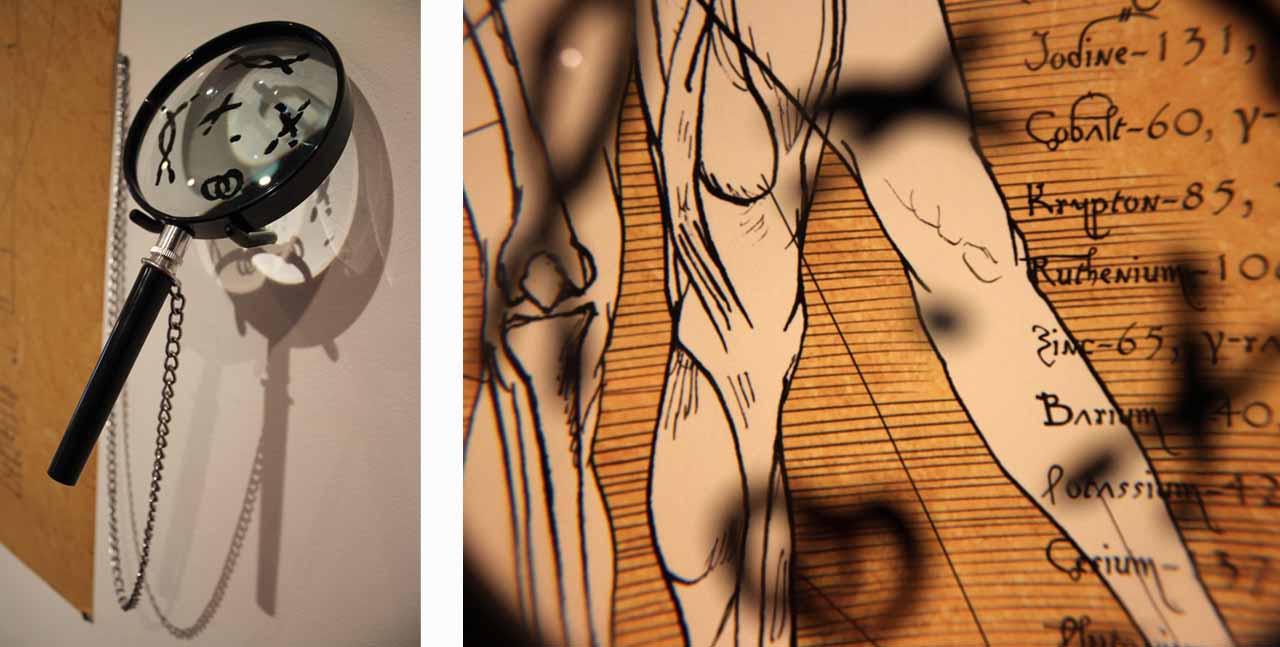
One of the effects of radiation exposure is chromosomal abnormalities or aberrations, which provoke the chromosomes to connect erratically or split repeatedly, causing illness such as cancers. By illustrating enlarged chromosomal abnormalities through looking into a magnifying glass, this work makes visible the world of the inner radiation exposure.
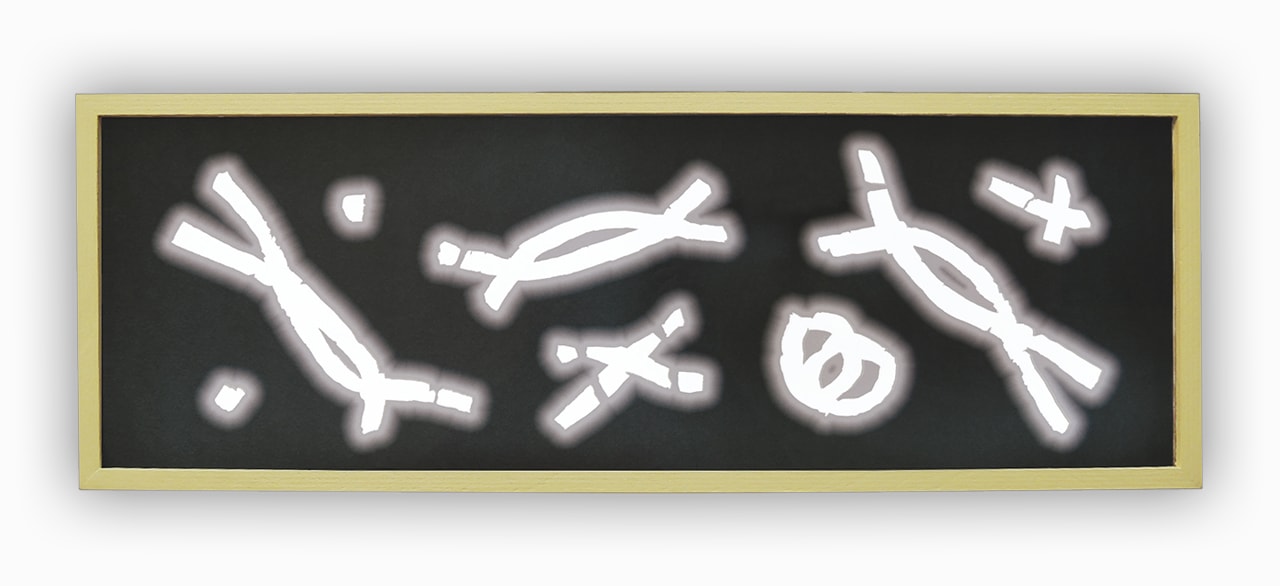
One of the effects of radiation exposure is chromosomal abnormalities or aberrations, which provoke the chromosomes to connect erratically or split repeatedly, causing illness such as cancers. This work makes visible the world of the inner radiation exposure by evoking a microscope observation of a specimen prepared on a glass slide on an X-ray view box.

This exhibition explored my new artistic concept: "Info Art." As information is becoming more persuasive in everyday lives, and that Art struggles to find its place and purpose in a data-intensive capitalist world, "Info Art" is an artistic approach in which aesthetic ideas could serve informative purposes and where each artwork can communicate, not only emotions and sensitivities, but also information and social/political messages to help create a more balanced and less conflicted world.
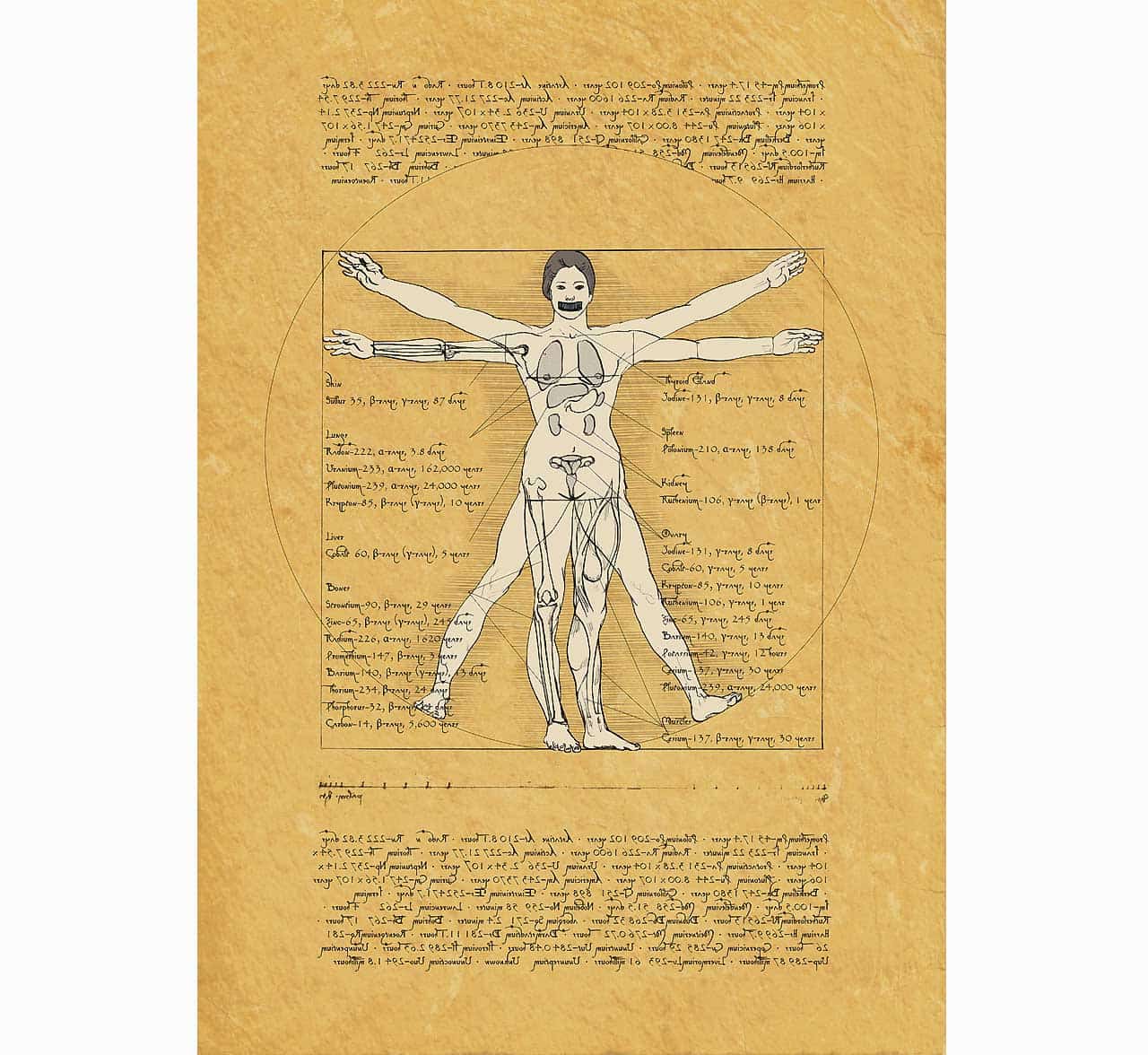
This work is based on the Vitruvian Man by Leonardo da Vinci which I consider an iconic representation of Post-Renaissance Western art, science, and culture. It is also inspired by the artwork Wisdom, Impression, Sentiment by Seiki Kuroda, a modern Japanese painter from the early 20th century who promoted Western academism in Japanese art. As a piece of "Info-Art," it aims to highlight and illustrate the effects of radiation in the interior of the human body (in particular within the female body), while at the same time raising questions about information control, (self-)repression of freedom of expression, historical and contemporary sociopolitical and cultural constraints, and self-censorship. This work got published in Invisible Colors: The Arts of the Atomic Age (Gabrielle Decamous, The MIT Press (Leonardo Series), Cambridge: Mass., USA, 2019, p. 290).
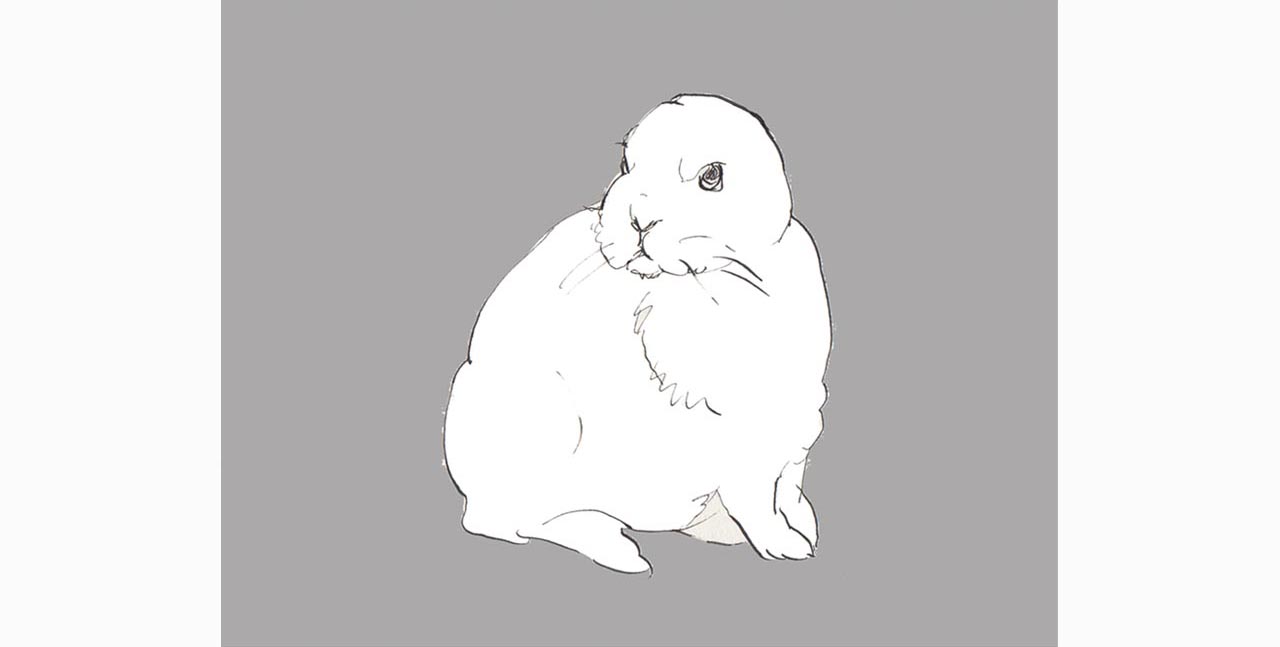
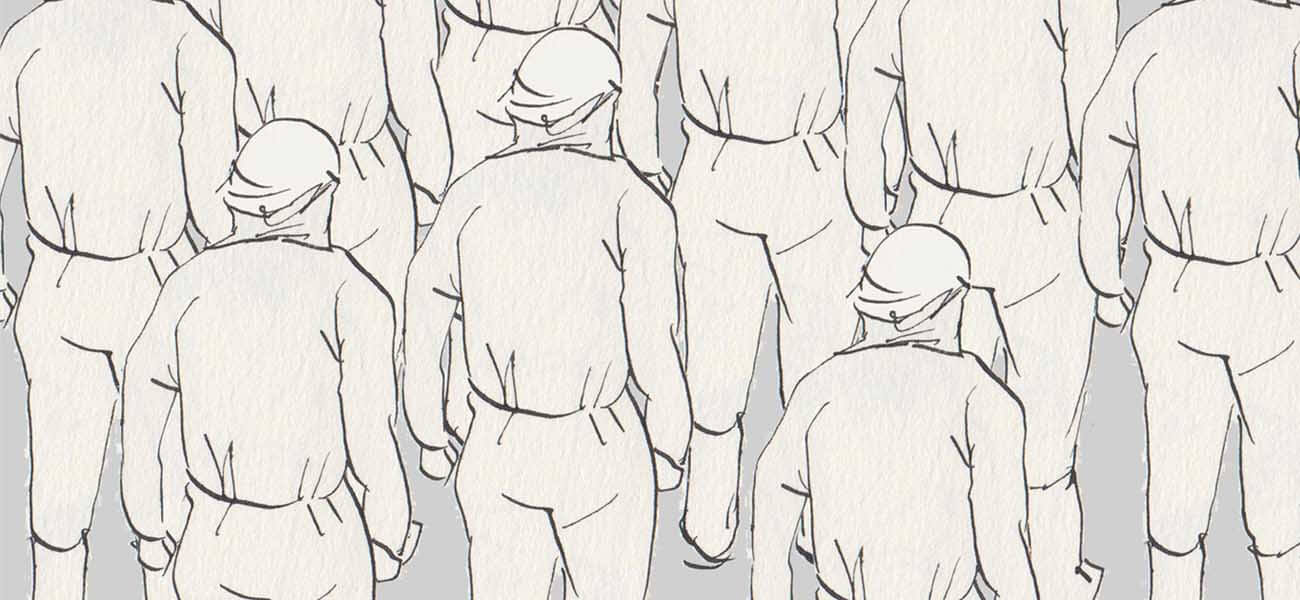
Limited Truth brings together various visualizations of nuclear and atomic energy from Japan's postwar history. This series of images foreground Japan's experience of this period through technical, cultural, and aesthetic symbols. Digital processing in the artworks represents how we receive, perceive and process media information and technology, while the analog approach represents the organic reactions of life. These images express the complex relationship between the imaginary, representation, and the investigation of the truth.
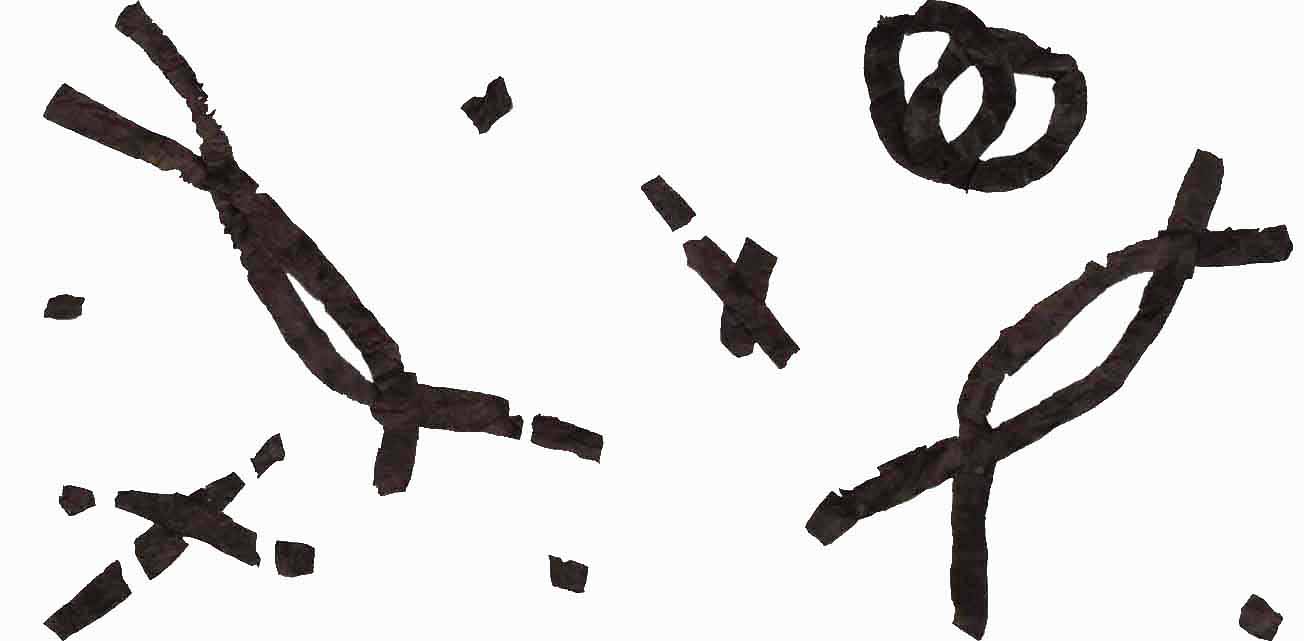
These illustrations of 46 enlarged chromosomal abnormalities caused by radiation make visible the world of the inner radiation exposure in an instinctive way. The moment when chromosomes are subject to metamorphosis / propagation is suggested. Every time blood circulates, chromosomes are cut off and are connected again, affected by radioactive material. This symptom is called chromosomal abnormality or aberration, as chromosomes connect erratically, and split repeatedly, causing illness, such as cancers.